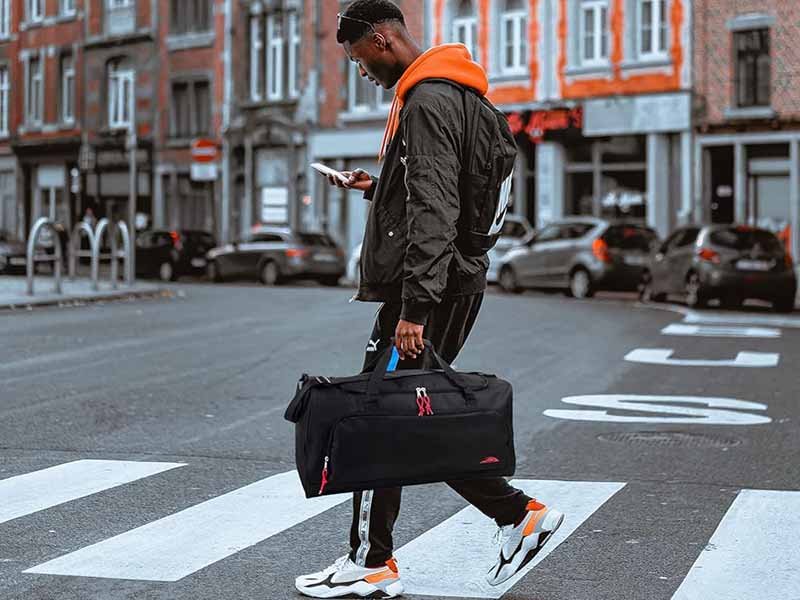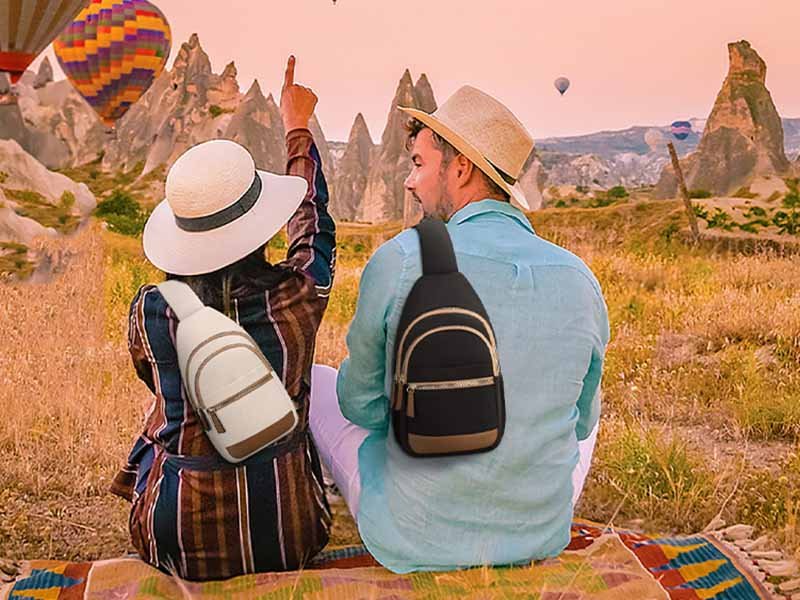For decades, the duffle bag has been the quiet hero of travel — durable, flexible, and unpretentious. From the worn canvas rolls of early sailors to today’s sleek nylon companions at airport terminals, the duffle’s story is one of evolution, not revolution. It’s the bag that adapts — to gym lockers, train carriages, and weekend escapes — earning its place as a global essential for people on the move.
A duffle bag is a soft-sided, cylindrical or rectangular carry bag made of fabric or leather, designed for travel, sports, or everyday use. Its appeal lies in its spacious design, lightweight build, and adaptability to multiple lifestyles and brand markets.
The beauty of a duffle bag isn’t in its shape — it’s in its purpose. It’s the travel partner that fits into every story: the overnight business trip, the gym-before-flight routine, or the long-haul expedition. And for brands, it’s a symbol of reliability, a blank canvas ready for design innovation and private-label customization.
At Szoneier, we’ve seen how a well-crafted duffle bag can define a brand’s identity. One client once told us: “Our customers didn’t just carry our logo — they carried our story.” That’s the power of a duffle bag. Let’s unpack why this simple silhouette continues to shape modern travel and lifestyle fashion across the world.
What Is a Duffle Bag?
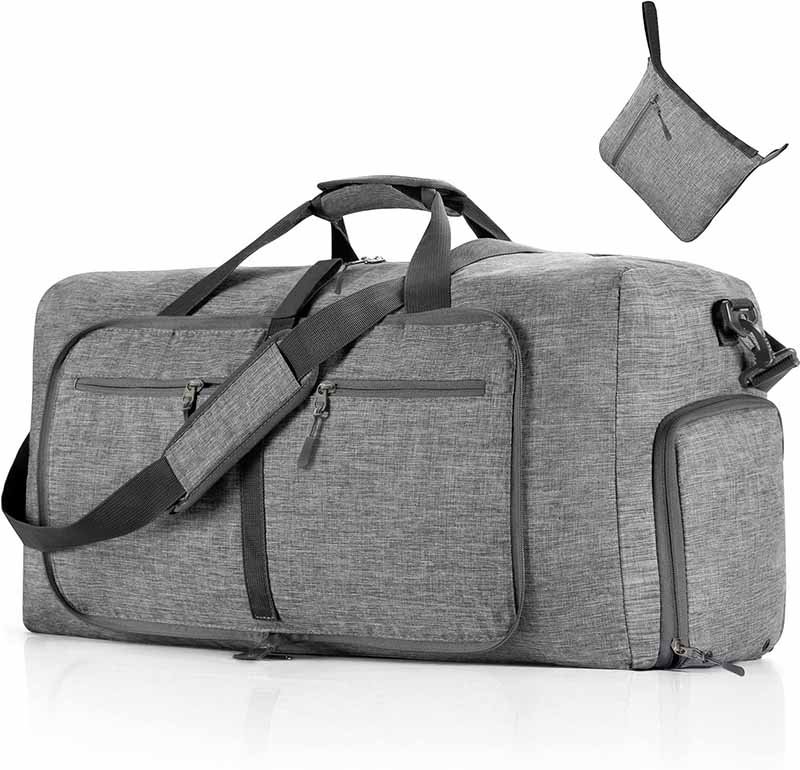
A duffle bag is a soft-sided cylindrical or rectangular bag made of canvas, nylon, polyester, leather, or tarpaulin. It’s designed for carrying clothes, sports gear, or travel essentials and is recognized for its spacious main compartment, lightweight structure, and versatile portability.
The True Definition of a Duffle Bag
A duffle bag, sometimes spelled “duffel bag,” is one of the most versatile and enduring bag types in the world. Its design—soft body, large storage capacity, and simple structure—makes it adaptable for nearly any purpose: travel, gym, sports, or even industrial transport. Typically, it’s made from durable woven fabrics such as 600D polyester, heavy canvas, or ballistic nylon, giving it a rugged form while staying flexible enough to pack and compress easily.
Modern duffle bags feature a zippered top opening, dual handles, and a removable or adjustable shoulder strap. Inside, they often include one large compartment and a few smaller pockets for organization. Unlike hard-shell luggage or backpacks, the duffle’s defining trait is its soft, collapsible frame, making it lightweight and space-efficient.
But the term “duffle” isn’t random—it has a story that stretches back over four centuries.
Why Do They Call It a Duffle Bag?
The name duffle originates from Duffel, a town in Belgium, known in the 17th century for producing a thick, coarse woolen cloth. Early military seamen and travelers used cylindrical sacks made from this fabric, tied at the top with a drawstring—thus, duffel bags were born. The original duffles were simple and rugged, made to withstand sea moisture and heavy handling during long voyages.
Over time, the term expanded beyond the fabric itself to describe the entire bag style, regardless of material. By the mid-20th century, “duffel” had entered English military vocabulary—especially during World War II, when soldiers carried cylindrical canvas holdalls. In modern spelling, “duffle bag” became more common in the U.S., while “duffel bag” remains the traditional European form.
At Szoneier, our design team honors this heritage by blending classic durability with modern innovation—transforming an old seaman’s sack into a travel essential with refined stitching, lightweight fabrics, and stylish branding possibilities.
How Has the Duffle Bag Evolved Over Time?
The duffle bag’s journey mirrors how society travels.
- Military to Civilian Transition: The duffle began as a military issue—unstructured, utilitarian, made for function over form. Soldiers loved its simplicity and capacity. When they returned home, they kept using it for personal travel, introducing it to civilian life.
- The Age of Modern Travel: The 1960s–80s brought mass tourism, airline travel, and the rise of sports culture. Manufacturers introduced nylon and polyester—lighter, water-resistant fabrics. The bag evolved into sleek, zippered forms with logos, handles, and compartments.
- The Lifestyle Revolution: Today, the duffle is no longer just a travel companion—it’s a fashion statement. Designers offer quilted PU duffles, eco-friendly RPET models, or luxury leather versions that blur the line between luggage and accessory. Influencers showcase them as part of “airport style” and “weekend aesthetics.”
- Smart and Sustainable Future: With new technologies, brands now experiment with smart duffles featuring USB charging, waterproof zippers, and RFID-blocking pockets. Meanwhile, factories like Szoneier adopt recycled yarns, solvent-free coatings, and REACH-compliant fabrics—ensuring your bag meets global sustainability standards without compromising performance.
Anatomy of a Duffle Bag
| Component | Function | Material Examples |
|---|---|---|
| Main Body | Holds main contents | 600D nylon, canvas, tarpaulin |
| Zippers | Access compartment | YKK metal, SBS resin |
| Handles & Strap | Carrying & load balance | Nylon webbing, padded grip |
| Lining | Protects interior | PU-coated polyester |
| Reinforced Base | Prevents wear & deformation | TPU sheet, rubber foot pads |
Each component influences not only the look and feel but also how your brand is perceived. A duffle with thick webbing and heavy-duty zippers speaks of adventure; one with matte PU and minimalist stitching communicates urban luxury.
Cultural Relevance and Modern Appeal
In 2026, duffle bags have become symbols of mobility and freedom. Whether it’s a startup founder commuting between coworking hubs or a digital nomad traveling across continents, the duffle represents adaptability.
Search data supports this: terms like “weekender duffle,” “carry-on duffle,” and “gym duffle bag” each receive over 60,000 global monthly searches, proving that consumers continue to seek personalized, functional, and stylish options.
What Are the Main Types of Duffle Bags?
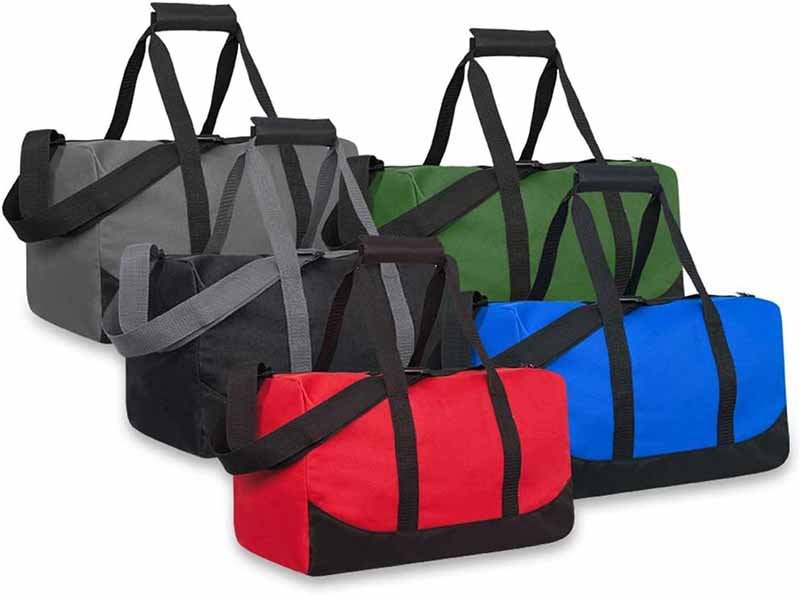
There are five main types of duffle bags — classic barrel, weekender, wheeled, convertible backpack, and foldable duffles. Each type differs in capacity, material, structure, and intended use, from daily gym routines to international travel and outdoor expeditions.
1. Classic Barrel Duffle
The barrel duffle is the original form — cylindrical, with a top zip and twin handles. It’s simple, strong, and highly adaptable.
Use Cases: Gym, daily commute, short trips Capacity: 30 L – 70 L Common Materials: 600D nylon, heavy canvas, or PU-coated polyester
These duffles typically have a single main compartment, making them lightweight and easy to pack. Their low material cost and efficient production make them ideal for entry-level retail or promotional branding.
Szoneier Insight: This type remains a bestseller for private-label clients because it offers broad appeal and easy logo placement on the front panel or strap band.
2. Weekender Duffle
A weekender duffle refines the barrel shape into a rectangular or trapezoidal structure with reinforced sides and inner organization pockets. Designed for 1- to 3-day trips, it bridges the gap between luggage and lifestyle accessory.
Use Cases: Business trips, leisure travel, fashion retail Capacity: 35 L – 55 L Materials: 420D nylon, vegan leather, cotton canvas, recycled RPET fabrics
This style emphasizes design and aesthetics — matte finishes, metal hardware, and minimalist silhouettes. For brands, the weekender duffle presents an opportunity to showcase texture storytelling, using color, lining, and branded zipper pulls.
| Feature | Classic Barrel | Weekender |
|---|---|---|
| Structure | Cylindrical, soft | Semi-structured, rectangular |
| Appearance | Sporty | Fashionable |
| Average Retail Price | $20 – $35 | $40 – $80 |
| Branding | Printed or embroidered | Embossed, debossed, metal logo |
3. Wheeled Duffle
The wheeled duffle merges soft-bag flexibility with suitcase convenience. It includes retractable handles, roller wheels, and reinforced frames.
Use Cases: Air travel, expeditions, long-term packing Capacity: 70 L – 120 L Materials: 900D oxford, tarpaulin, ballistic nylon
Though heavier and more complex to manufacture, wheeled duffles command a premium retail position and appeal to the travel and sports-equipment sectors. Factories like Szoneier incorporate PE or EVA base plates and metal axle wheel units to enhance durability and pass load-drop testing (up to 25 kg weight impact).
4. Convertible Backpack-Duffle
This hybrid model adds hidden shoulder straps or a dual-carry system that converts the bag from hand-carry to backpack mode. It fits urban and outdoor lifestyles where mobility is key.
Use Cases: City commuting, hiking, travel for younger demographics Capacity: 40 L – 80 L Materials: Ripstop nylon, 600D oxford, waterproof TPU
Brands targeting millennials or digital nomads love this format — it’s ergonomic, practical, and versatile. The dual straps require reinforced stitching and comfort padding, increasing quality perception.
Szoneier Design Tip: Many OEM clients combine black or grey fabrics with subtle reflective strips to enhance visibility and modern appeal.
| Attribute | Convertible Duffle | Regular Backpack |
|---|---|---|
| Structure | Soft, wide opening | Vertical, compact |
| Comfort | Moderate (dual use) | High (weight distribution) |
| Storage | Large single space | Multi-pocket system |
| Ideal Users | Travelers, gym goers | Students, hikers |
5. Foldable or Packable Duffle
Designed for convenience and portability, foldable duffles collapse into their own pocket or pouch, taking up minimal space when not in use.
Use Cases: Emergency carry-on, short trips, backup storage Capacity: 20 L – 40 L Materials: 210D – 300D ripstop polyester, ultralight nylon
These bags are cost-efficient and ideal for promotional campaigns or secondary sales (e.g., bundled travel accessories). They weigh under 0.6 kg, fold flat, and can be produced in a wide color range with printed logos.
Szoneier Example: A European airline client ordered 10,000 branded foldable duffles as part of an in-flight merchandise campaign — low MOQ and high visibility at minimal cost.
Emerging Niche Variations
Beyond the five main types, the duffle category continues to innovate:
- Waterproof Duffles: Tarpaulin or TPU-laminated fabrics for outdoor or marine use.
- Smell-proof Duffles: Multi-layer activated-carbon linings for cannabis or fishing markets.
- Fire-resistant or Anti-theft Duffles: Special coatings and hidden zipper systems.
These specialized subcategories are fast-growing segments in 2025, especially for private-label buyers seeking differentiation in competitive markets.
Which Materials Work Best for Duffle Bags?
Materials influence durability, weight, cost and market position. For example:
- Canvas: heavy, rugged, vintage look.
- Nylon/Polyester: lightweight, high strength-to-weight, wide colour options.
- Tarpaulin or coated fabrics: high-end waterproof travel duffles.
- Leather accents or full leather: premium fashion segment. Make sure your material aligns with your target price tier and branding story.
What’s the Difference Between a Gym Bag and a Duffle Bag?
Though often used interchangeably, a “gym bag” usually emphasises sports gear, ventilation compartments (for shoes/wet clothes), separate pockets, lower capacity (~40-60 L). A standard duffle bag may be more general-purpose travel use, larger volume, fewer sports-specific features.
How Is a Duffle Bag Designed and Manufactured?
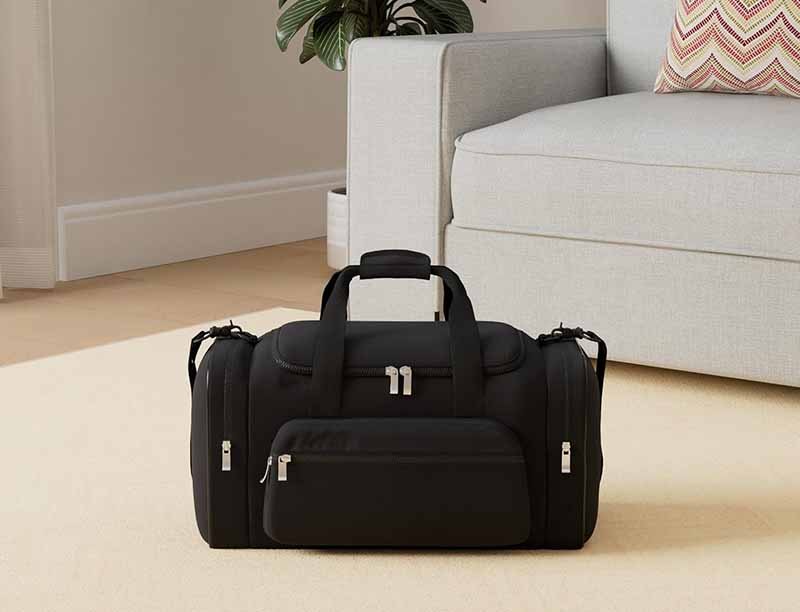
A duffle bag is designed and manufactured through a step-by-step process that includes concept design, material selection, pattern making, cutting, stitching, reinforcement, branding, quality inspection, and packaging. Each stage ensures the final product meets the desired balance of durability, functionality, and brand aesthetics.
1. Design and Product Specification
Before a single thread is sewn, design defines the bag’s destiny.
| Step | Description | Key Deliverables |
|---|---|---|
| Market Analysis | Identify customer needs (gym, travel, tactical, luxury) | Use case definition |
| Sketch & CAD Design | Develop 2D sketches and 3D CAD models | Bag dimensions, proportions |
| Material Selection | Choose fabric (nylon, polyester, tarpaulin, leather) based on use case | Material samples |
| Hardware Selection | Select zippers, buckles, hooks, wheels (if any) | BOM (Bill of Materials) |
| Prototype Brief | Finalize size, features, color, branding, packaging | Technical datasheet |
Szoneier Tip: During design phase, we recommend deciding on branding locations (logo, woven label, zipper pull) early — adjusting panel sizes later is costlier.
2. Pattern Making and 3D Prototyping
Once the design is approved, pattern engineers translate it into precise templates that define every cut and seam.
Pattern making involves:
- Defining panel layout (front, back, base, sides, pockets).
- Adding seam allowances (typically 0.8 – 1.2 cm).
- Considering material stretch and reinforcement zones.
- Digitizing patterns into CAD for laser or die cutting.
Example: For a 60 L duffle, Szoneier typically uses 18–25 unique pattern pieces, depending on features (shoe compartment, lining pockets, etc.).
3. Material Cutting and Lamination
With final patterns ready, the next stage is fabric preparation and cutting.
| Operation | Purpose | Technology |
|---|---|---|
| Fabric Inspection | Ensure no color fading, wrinkles, or defects | Lightbox inspection |
| Lamination or Backing | Add structure and waterproofing (PU/TPU coating) | Heat press laminator |
| Marker Planning | Optimize cutting layout to minimize waste | CAD nesting software |
| Cutting | Cut layers according to patterns | Automatic laser / die-cutting machine |
For heavier duffles (like tarpaulin or canvas), cutting precision is critical — even a 2 mm misalignment can distort panel symmetry during stitching.
Szoneier often uses laminated composites — for instance, 600D polyester + 2 mm foam + PU backing — to enhance texture and strength.
4. Stitching, Assembly, and Reinforcement
This is the most labor-intensive part — the heart of bag manufacturing.
A. Pre-Stitch Preparation
- All components (zippers, webbing, linings) are pre-cut and organized.
- Branding elements such as embroidered patches or silk-printed logos are applied before main assembly.
B. Main Assembly Process
- Front & Back Panels – pockets and decorative features sewn first.
- Zipper Installation – reinforced with binding tape or seam seal.
- Side and Base Joining – key stress points double-stitched or bar-tacked.
- Strap Attachment – handles secured with “X-box” or “Bartack” reinforcement.
- Lining Integration – inner shell stitched or glued depending on style.
Technical Fact: A mid-size duffle bag typically contains 1,800–2,400 individual stitches, with up to 12 separate seam types (flatlock, binding, piping, bartack, etc.).
C. Reinforcement
- Bottom Base: Added PE or EVA board + TPU sheet for structure.
- Stress Points: Bartack stitching (8–10 per bag).
- Load Testing: Random units tested to support 15–25 kg without deformation.
Quality Tolerance: ±2 mm stitching deviation across panels, verified by digital calipers during inspection.
5. Branding, Hardware, and Finishing Touches
Brand presentation elevates a duffle bag from a commodity to a collectible.
Branding Options:
- Embroidery or Woven Label: Best for canvas or nylon styles.
- Screen Printing / Heat Transfer: For polyester or coated surfaces.
- Embossed Leather Patch: Luxury feel for fashion lines.
- Metal Plate / Silicone Badge: Premium retail positioning.
Hardware Installation:
- Zippers (YKK, SBS, or custom branded).
- Buckles (zinc alloy, ABS plastic).
- Pullers, D-rings, and shoulder hooks.
Final Finishing:
- Edge binding to conceal raw seams.
- Cleaning and thread trimming.
- Quality seal tags and hang labels added for export.
Szoneier Practice: Every finished bag undergoes a visual and tactile inspection — checking not just stitching accuracy but also zipper glide and handle comfort, since these affect the buyer’s first impression.
6. Quality Control and Testing
Before leaving the factory, duffle bags pass through multi-stage quality checks based on AQL (Acceptable Quality Level) standards.
| Test | Purpose | Standard |
|---|---|---|
| Load Test | Verify handle/strap durability | 20 kg x 1 hour hang |
| Seam Strength | Prevent tearing under stress | ASTM D1683 |
| Color Fastness | Ensure no fading or bleeding | ISO 105-X12 |
| Water Resistance | For coated/laminated fabrics | Hydrostatic head ≥ 1,000 mm |
| Zipper Cycle Test | Longevity test for closure | 5,000 open-close cycles |
Real Example: A 90 L waterproof duffle made by Szoneier for a European client passed a 72-hour humidity test at 95% RH — proving the seam bonding and TPU lamination met export-grade travel standards.
7. Packaging and Export Readiness
Once QC passes, each duffle goes through a meticulous packing process:
- Individual Packing: Polybag or recyclable paper wrap.
- Carton Packing: 5–10 pcs per carton, labeled with SKU, PO, and barcode.
- Palletization: For sea shipment, cartons are stretch-wrapped for moisture control.
Optional Add-ons: hang tags, instruction cards, warranty slips, and QR-coded sustainability info. Szoneier also supports drop-shipping and FBA (Fulfilled by Amazon) logistics for international clients — ensuring bags arrive retail-ready.
What Are Duffle Bags Used For Today?
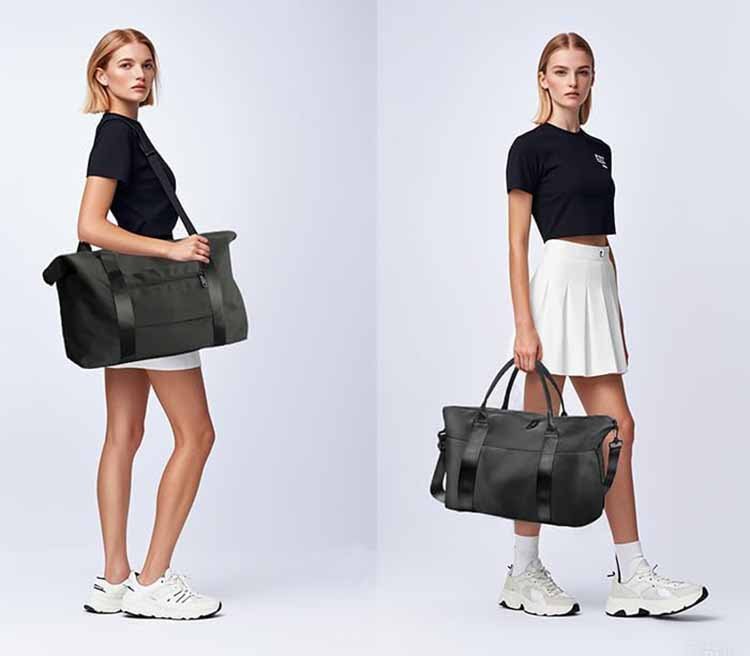
Duffle bags are used for travel, gym, sports, outdoor adventures, business trips, and daily commuting. Their lightweight, flexible, and spacious design makes them ideal for modern lifestyles that demand portability, multifunctionality, and brand personalization.
Why the Duffle Bag Has Become a Modern Essential
Few bag designs have achieved the universal practicality of the duffle bag. Once a rugged military sack, it’s now a must-have accessory for people of all ages — from athletes to executives, students to travelers. Its success lies in one timeless equation: maximum space + minimal structure.
In today’s fast-paced, hybrid lifestyles, users expect one bag that can move seamlessly from gym locker to airplane overhead bin. The duffle fulfills that role effortlessly. For brands, it’s no longer just a product — it’s a category that bridges fashion, function, and emotional connection.
1. Duffle Bags for Travel
Use: Weekend getaways, business trips, carry-on luggage, or global travel. Typical Capacity: 40L–90L Preferred Materials: 600D polyester, tarpaulin, ballistic nylon, or RPET
Travelers choose duffles for their soft structure and expandability, making them perfect for packing clothes, shoes, and tech accessories without rigid limitations. Many modern travel duffles include trolley sleeves, detachable shoulder straps, and waterproof linings.
| Travel Duffle Feature | Benefit |
|---|---|
| Lightweight soft shell | Easier to carry, fits in overhead bins |
| Wide main opening | Faster packing/unpacking |
| Water-resistant coating | Protection during outdoor travel |
| Shoe or wet compartments | Hygienic separation |
| Add-on strap systems | Adapts to luggage handles |
Szoneier Case Example: A 65L tarpaulin duffle designed for a European travel brand passed a 25 kg load test and was customized with an airline-compatible dimension of 55 × 35 × 25 cm, fitting carry-on regulations for most airlines. It became their bestseller within two months of launch.
2. Duffle Bags for Sports and Fitness
Use: Gym workouts, yoga, swimming, team sports, and fitness travel. Typical Capacity: 30L–60L Preferred Materials: 600D nylon, mesh-laminated polyester, or PU-coated canvas
The gym duffle has evolved from a simple gear holder into a performance-driven product. Today’s athletes demand ventilated shoe compartments, moisture-resistant linings, and dedicated pockets for water bottles or accessories.
Key Design Elements:
- Ventilation Panels: Prevent odor buildup from used clothes or sneakers.
- Waterproof Base: Protects contents from wet floors.
- Quick-Access Zippers: Allows fast retrieval of small items.
- Reflective Strips: For night visibility (popular in urban fitness markets).
Trend Insight: According to Google Trends (2026), global searches for “gym duffle bag” and “sports duffle bag with shoe compartment” increased 43% year-over-year, proving the strong consumer demand for function-rich fitness bags.
For brands, gym duffles offer a profitable middle-tier product: functional, stylish, and highly customizable — ideal for adding brand logos and motivational taglines.
3. Duffle Bags for Outdoor and Adventure Use
Use: Camping, hiking, mountaineering, overland expeditions. Typical Capacity: 60L–120L Preferred Materials: Tarpaulin, waterproof TPU, heavy-duty 900D nylon
Outdoor duffles are engineered for durability, not just looks. They must withstand rain, dust, UV exposure, and rough terrain. These models often feature welded seams, compression straps, and MOLLE systems (modular attachment panels).
| Feature | Outdoor Benefit |
|---|---|
| Waterproof tarpaulin shell | Keeps gear dry in harsh conditions |
| Reinforced base and handles | Supports heavy loads |
| Lockable zippers | Prevents accidental opening |
| Compression straps | Reduces volume for compact transport |
| Backpack straps | Converts for hands-free carry |
4. Duffle Bags for Business and Urban Commuting
Use: Work travel, gym-to-office routine, overnight corporate trips. Typical Capacity: 30L–45L Preferred Materials: PU leather, 420D nylon, RPET twill, or canvas
In the age of hybrid work, professionals want one versatile bag that transitions from the boardroom to the gym. The business duffle combines structure with subtle luxury — padded laptop sleeves, smart organization, and clean silhouettes.
Popular Features:
- Laptop and tablet compartments
- Power-bank or USB charging ports
- RFID-protected pockets
- Trolley sleeves and shoulder padding
- Matte or vegan leather finishes
Market Observation: Urban commuter duffles are among the fastest-growing categories in online retail, with Amazon and Shopify stores reporting an annual growth rate of 28% in this segment since 2023. Brands adopting minimalist aesthetics — like monochrome PU or canvas duffles — outperform traditional bulky designs.
5. Duffle Bags for Daily and Lifestyle Use
Use: Everyday errands, school, short activities, and personal storage. Typical Capacity: 20L–35L Preferred Materials: Cotton canvas, denim, lightweight polyester
Lifestyle duffles blur the line between accessory and utility. These bags focus on fashion, texture, and personality, becoming a canvas for branding creativity. Retailers often launch them as part of seasonal or influencer collaborations.
Example: A Japanese streetwear brand collaborated with Szoneier to produce a limited run of denim duffles featuring contrast stitching and embroidered monograms. Despite its compact 25L capacity, the model sold out within weeks — proving how aesthetic differentiation drives value.
6. Specialized Duffles: Fireproof, Smellproof, and Cooler Bags
As the duffle category expands, niche functions create new market opportunities:
- Fireproof Duffles: Made with fiberglass-coated fabric or silicone-glass blends, suitable for document storage or fire-resistant travel kits.
- Smellproof Duffles: Incorporate activated carbon liners, ideal for cannabis, fishing, or shoe industries.
- Cooler Duffles: Insulated PEVA linings and waterproof shells for picnic, camping, or food delivery markets.
| Duffle Type | Material | Function | Szoneier Application |
|---|---|---|---|
| Fireproof | Silicone-coated fiberglass | Protects from 1200°C heat | Fireproof document bag |
| Smellproof | Activated carbon + nylon | Odor containment | Discreet travel bags |
| Cooler | PEVA + aluminum foil lining | Keeps temperature constant | Insulated travel duffle |
7. Duffle Bags for Branding and Promotional Campaigns
Duffles are one of the most effective promotional bag types thanks to their large printable surface and high perceived value. They serve as corporate gifts, event merchandise, or influencer giveaways.
- Low MOQ production (100–300 units).
- Quick sampling (5–7 days).
- Custom color matching (Pantone accuracy ±5%).
- Printing methods: silk screen, heat transfer, sublimation, embroidery.
Real Client Story: A global beverage brand ordered 8,000 foldable duffles with logo placement across handles and sides for a summer roadshow. Lightweight and practical, the bags doubled as both gift and mobile advertisement.
The Emotional Role of Duffles in Modern Lifestyles
Beyond utility, the duffle represents freedom, mobility, and identity.
- For travelers — it’s the promise of movement.
- For athletes — a symbol of discipline.
- For brands — a medium for storytelling.
Research by McKinsey Travel & Consumer Insights 2024 found that 68% of consumers associate duffle bags with “active lifestyle” and “individual expression.” This emotional resonance is why so many brands continue to invest in customizable duffle collections.
What Is the Difference Between a Duffle Bag and a Travel Bag?
While “travel bag” is broad (could be suitcase, roller, weekender), a duffle specifically emphasises soft-side, flexible structure and often simpler fabrication. Travel bags may incorporate rigid frames, wheels, multiple compartments; the duffle remains soft, collapsible, versatile. Your brand may offer both side by side: duffle for quick trips, travel suitcase for longer journeys.
Is a Duffle Bag Better Than a Backpack or Suitcase?
There’s no universal “better.” It depends on user need. A duffle is more flexible than a suitcase (can fit awkward items, compressible for storage) but may offer less structure or organisation. A backpack frees hands and distributes weight; a suitcase offers protective structure and wheels. A high-quality OEM duffle (like one produced by Szoneier) aims to combine flexibility with durability to bridge lifestyle and travel.
How to Choose the Right Duffle Bag for Your Market or Brand?
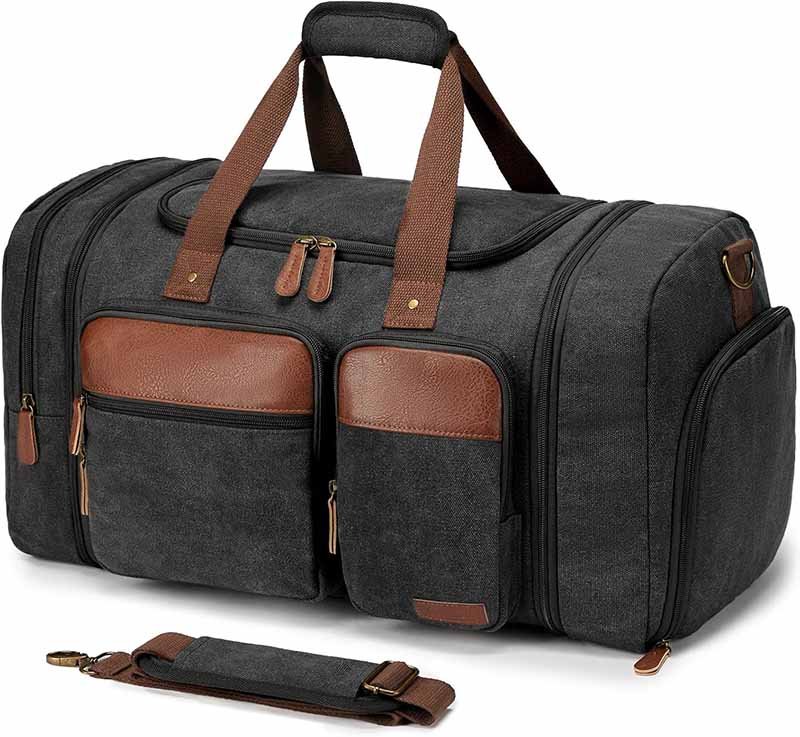
To choose the right duffle bag for your market or brand, consider your target audience, purpose, material, size, price tier, and customization options. The best design aligns with your customers’ lifestyles and your brand’s positioning — whether sporty, luxurious, eco-friendly, or functional.
1. Identify Your Target Audience
Before design, define who will carry your bag and why. Each market segment values different features:
| Target Group | Typical Bag Type | Priorities | Suggested Capacity | Ideal Material |
|---|---|---|---|---|
| Gym & Fitness Users | Barrel or compact duffle | Breathable shoe pocket, lightweight | 30–45 L | 600D polyester, mesh-laminated nylon |
| Frequent Travelers | Weekender or wheeled duffle | Multi-pocket, durable zippers | 50–90 L | 900D oxford, tarpaulin |
| Outdoor Enthusiasts | Waterproof adventure duffle | Weatherproofing, straps, compression | 70–120 L | TPU-laminated nylon, tarpaulin |
| Business Professionals | Urban commuter duffle | Laptop sleeve, elegant finish | 30–45 L | PU leather, RPET twill |
| Lifestyle Consumers | Foldable or design-forward | Fashion, prints, portability | 20–35 L | Canvas, cotton, denim |
2. Define Purpose and Use Case
A duffle’s function determines its construction.
Ask: Where will it go? Who will use it? What will it carry?
| Use Case | Must-Have Features | Recommended Design |
|---|---|---|
| Weekend Getaways | Zippered top, organized pockets, removable strap | Weekender style |
| Daily Gym Use | Ventilated compartment, water bottle pocket | Barrel duffle |
| Outdoor Travel | Waterproof fabric, compression straps | Adventure duffle |
| Corporate Commuting | Laptop sleeve, trolley strap | Business duffle |
| Retail Promotion | Lightweight, printable surface | Foldable duffle |
A common mistake new brands make is overbuilding (too many features for an entry-level market) or underbuilding (cheap materials in a premium segment). At Szoneier, we tailor each build to the target retail price and buyer demographic.
3. Choose the Right Materials and Construction
Materials communicate brand positioning as much as logos do. A PU duffle and a tarpaulin duffle tell completely different stories.
| Material Type | Visual Appeal | Durability | Suitable Market |
|---|---|---|---|
| Canvas (Cotton or Blended) | Natural, rugged | Medium | Lifestyle, heritage |
| 600D Polyester | Matte, structured | Good | Entry-level sports |
| 900D Nylon / Oxford | Technical, strong | Excellent | Travel, tactical |
| TPU/Tarpaulin | Glossy, waterproof | Excellent | Outdoor, waterproof |
| PU Leather | Premium, smooth | Medium-high | Urban, business |
| RPET / Recycled Fabric | Eco-conscious | Good | Sustainable collections |
Manufacturing Insight: Each fabric behaves differently during sewing. For example, PU leather requires slower stitching speed and thicker needles, while tarpaulin needs heat-sealing instead of standard sewing. Choosing the correct construction technique ensures a professional finish and long-term reliability.
4. Optimize Size, Volume, and Structure
Capacity isn’t just about liters — it defines user experience.
| Capacity | Typical Use | Weight Range | Notes |
|---|---|---|---|
| 20–35 L | Everyday carry or gym | 0.6–1 kg | Compact, cabin size |
| 40–60 L | Weekend or fitness travel | 0.8–1.2 kg | Balanced for short trips |
| 70–90 L | Extended travel | 1.2–2 kg | Needs reinforced base |
| 100 L+ | Expedition or team sports | 2–3 kg | May require wheels or frame |
- Compact duffles (30–45 L) appeal to urban users who value convenience.
- Mid-range duffles (50–70 L) serve as the travel-gym crossover.
- Large duffles (80 L+) are preferred by outdoor and logistics users.
Szoneier Tip: Always match your duffle size to transport regulations — e.g., airline cabin size 55 × 35 × 25 cm. Compliance boosts sales in e-commerce because customers can easily visualize fit.
5. Align Features and Branding With Market Tier
Think of feature depth as the balance between function and profit. Premium products justify higher price points through detailing; budget lines prioritize quantity and visibility.
| Market Tier | Price Range (Ex-Factory) | Typical Features | Branding Approach |
|---|---|---|---|
| Budget / Entry | $8–15 | Simple structure, 1–2 pockets | Printed or woven logo |
| Mid-Range | $16–30 | Inner pockets, shoe compartment, reinforced base | Embossed patch, embroidery |
| Premium | $31–50+ | Waterproof lining, high-end zippers, padded handles | Metal plate or custom hardware |
| Luxury | $60+ | Full-grain leather, polished hardware, minimalist seams | Debossed leather logo |
If your brand sells across multiple tiers, ensure visual cohesion — color schemes, zipper pulls, and packaging style should still feel connected under one brand DNA.
6. Customize for Branding and Visual Identity
Your duffle isn’t just a utility product — it’s a moving billboard for your brand. Effective customization strengthens recognition, trust, and resale value.
Branding Techniques at Szoneier:
- Silkscreen or Heat Transfer Printing: Cost-effective, great for nylon or polyester.
- Embroidery / Woven Patch: Premium texture for canvas or oxford.
- Embossed or Metal Logo Plate: High-end visual impact for PU or leather duffles.
- Custom Webbing or Zipper Pullers: Creates unique tactile brand feel.
- Color Matching: Pantone-accurate color reproduction within ±5% tolerance.
Packaging Matters Too: Include logo hang tags, custom dust bags, and QR-coded inserts linking to your brand story or sustainability page.
Example: For a boutique Scandinavian brand, Szoneier created a matte black 50 L duffle with tone-on-tone embossed logo, recycled lining, and laser-etched metal pullers. The minimalist look aligned with the client’s “Nordic Calm” branding — resulting in a 28% higher sell-through rate compared to previous imports.
7. Balance MOQ, Cost, and Production Timeline
Every OEM/ODM buyer must find the sweet spot between design ambition and commercial reality.
| Factor | Entry-Level | Mid-Tier | Premium |
|---|---|---|---|
| MOQ | 100–300 pcs | 300–800 pcs | 500–1000 pcs |
| Sampling Time | 5–7 days | 7–10 days | 10–15 days |
| Lead Time (Production) | 25–30 days | 30–40 days | 40–50 days |
| Customization Depth | Logo & color | Logo, pattern, materials | Full design + hardware mold |
Szoneier’s in-house R&D and prototyping departments help streamline development — so clients can test the market with smaller batches before scaling production. This minimizes risk while ensuring speed to market.
Conclusion
In a world that never stops moving, the duffle bag remains a symbol of freedom, versatility, and design intelligence. It’s not just a container for clothes or gear — it’s a representation of how people travel, work, train, and live. From the daily gym commute to the long weekend escape, it adapts to every story with quiet confidence.
For brands, choosing the right duffle bag is more than a product decision — it’s a chance to express identity. The texture of the fabric, the weight of the zipper, the subtle curve of a handle — these are the unspoken details that separate ordinary merchandise from a brand-defining accessory. Whether you’re a sportswear startup, a travel label, or a lifestyle brand, your duffle line tells customers who you are before they even see your logo.
Whether you need 100 pieces for a boutique launch or 10,000 units for a global rollout, we make it seamless, fast, and reliable.
Let’s start designing your custom duffle collection today.

